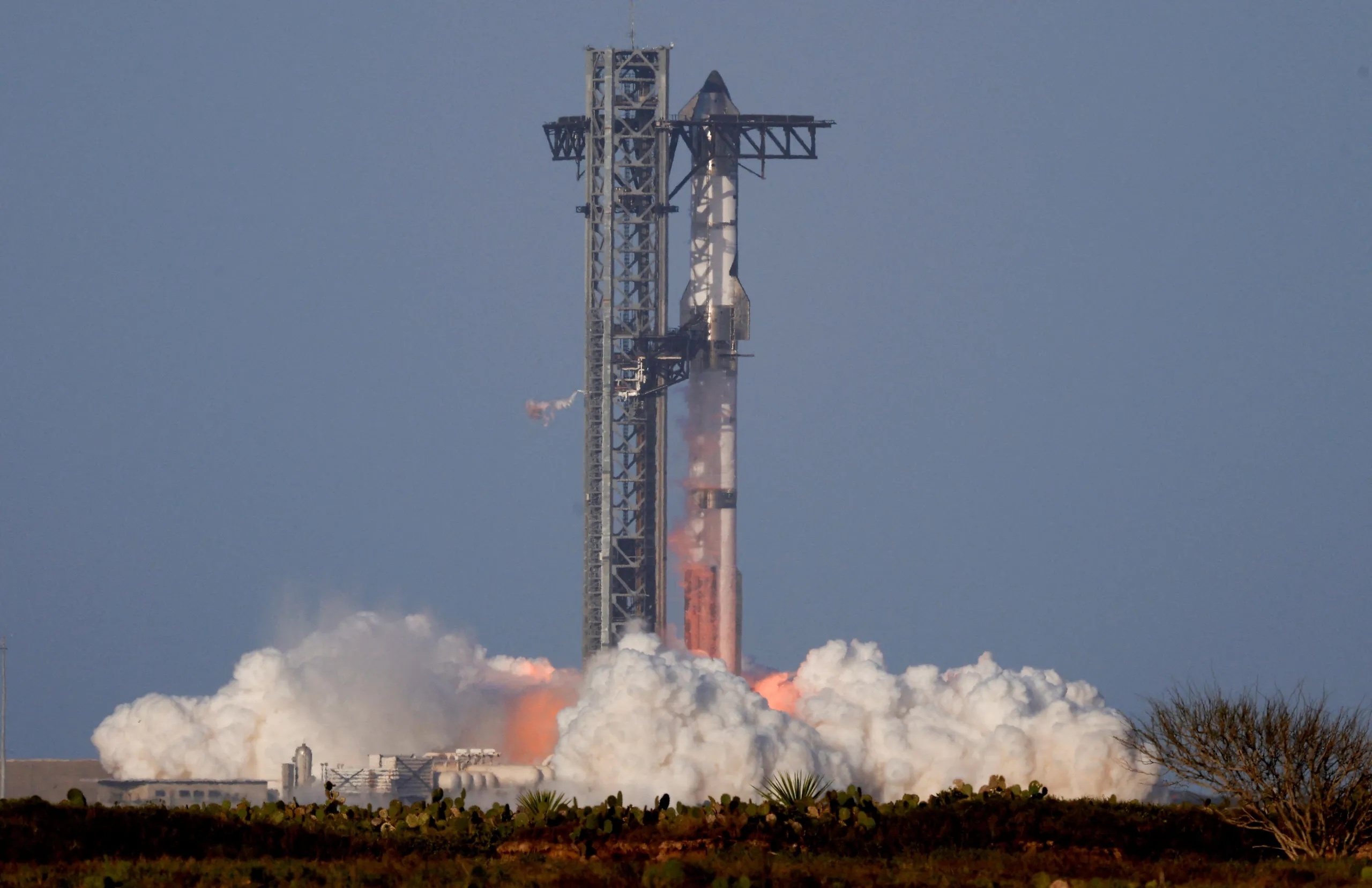24.05.2025
- Cape Canaveral residents are concerned about potential structural damage to buildings caused by increasingly frequent and powerful rocket launches.
- A study by Florida Tech will measure noise, vibration, and air quality impacts of launches on buildings in Cape Canaveral.
- SpaceX plans to significantly increase Falcon 9 launches and introduce the much larger Starship rocket, raising concerns about the impact on older structures.

SpaceX's next-generation Starship spacecraft atop its Super Heavy booster is launched March 6 on its eighth test at the company's Boca Chica launch pad in Brownsville, Texas.
With rocket launches on the rise, Cape Canaveral condominium resident Lilian Myers worries that window-clattering liftoffs may already be inflicting structural damages to her fourth-floor condo and surrounding 35-unit building.
Looking ahead, SpaceX seeks to increase annual Falcon 9 rocket launches from 50 to 120 from Cape Canaveral Space Force Station alone. And soon, SpaceX will bring massive Starship rockets and Super Heavy boosters — the most powerful rocket system in history — to Florida's Space Coast.
A single Starship launch generates the noise equivalent of at least 10 Falcon 9 launches, a Brigham Young University research team determined after analyzing the colossal rocket's fifth Texas test flight last October.
“The years have gone by, and the window-rattling has gotten to be worse — and a crack in my ceiling has appeared. And a crack that goes all the way from the base of our building to the fifth story, that was recently repaired," Myers told the Cape Canaveral City Council last month.
"(That) began to illustrate for us the potential impacts on the built environment here,” Myers said.
In a proactive move, the Cape Canaveral City Council unanimously approved an upcoming $10,019 rocket launch impact study with the Florida Institute of Technology. Researchers will install sensor suites this summer at a handful of municipal and privately owned buildings across the 1.9-square-mile city, collecting data on decibel levels, vibrations and air quality before, during and after every launch through at least May 2026.
Space Force officials project an unprecedented 107 orbital rockets may launch this year from Florida's Space Coast, with that annual sum expected to continue climbing to new records.
The Florida Tech study will employ decibel meters and accelerometers to collect measurements from dozens of liftoffs and sonic booms, primarily from Falcon 9s, during the coming months. This will provide a unique, preliminary data baseline in advance of Starship operations.
"The community concern is about the structures. There are a significant number of older structures that are not necessarily built to the recent building codes," said Hamidreza Najafi, a Florida Tech associate professor of mechanical engineering and director of the university's Innovations in Sustainable Energy and Thermal Systems lab.
"So there are concerns that the increasing frequency and increasing strength of rocket launches could potentially impact them, causing formation of cracks," Najafi said.
Starship's potential future liftoffs from Launch Complex 37 at Cape Canaveral Space Force Station would occur 9 miles from the closest city condominium and 10.4 miles from City Hall, said Zachary Eichholz, chief resilience manager for the city of Cape Canaveral.
During Starship's fifth test flight last October in Texas, BYU researchers noted the booster's thunderous flyback sonic boom triggered car alarms near sound-monitoring stations in Port Isabel (6.3 miles away) and South Padre Island (10.3 miles).
Eichholz said City Hall is receiving calls from residents worried about possible structural damages from ever-increasing launches and booster-landing sonic booms. However, he said this information remains anecdotal in nature.
"We have to have a better understanding as a city what is going on around us, especially with the increase in frequency. If it was happening once a month, as it used to kind of happen, that's a different story," Eichholz said.
"But now when you're talking multiple launches a day, that can certainly cause impacts that we want to better understand," he said.
Launch rate accelerating, with Starship in the wings
The Cape Canaveral-Florida Tech rocket launch impact study comes amid a historically unprecedented surge in orbital launches from Cape Canaveral Space Force Station and NASA's Kennedy Space Center:
- Annual launches have surged to successive records of 31 liftoffs in 2021, 57 in 2022, 72 in 2023, and 93 last year. This year's cadence is clocking in faster.
- SpaceX seeks a Federal Aviation Administration license modification to send up to 120 Falcon rockets per year from Launch Complex 40, accompanied by up to 34 annual sonic-boom-producing booster landings. A draft environmental assessment is under review.
- And the proverbial elephant in the room: SpaceX is building a launch tower and facilities at pad 39A at KSC for the immense Starship-Super Heavy launch system. SpaceX also seeks environmental approvals to send up Starships from the reconstructed Launch Complex 37 at the Space Force station, miles closer to Cape Canaveral city limits.
The two-stage Starship-Super Heavy booster combo stands 403 feet high, dwarfing the 229-foot Falcon 9s that frequently launch on Starlink missions from Florida's Space Coast. SpaceX media personnel did not respond to messages seeking comment for this story.
On May 22, the FAA granted SpaceX "return to flight" approval for its upcoming ninth Starship test flight from Boca Chica in South Texas. The past two missions ended when the massive rocket's upper stage broke apart into manmade meteor showers.
"SpaceX is pushing to rapidly develop, test, and eventually regularly fly its Starship launch vehicle, a super heavy lift rocket with twice the power of the Saturn V rocket that first brought humans to the moon in 1969," a Cape Canaveral City Hall press release said.
"As part of its growing contracted launch manifest, in combination with being an integral part of NASA’s Artemis Program, SpaceX intends to launch dozens of Starship flights from the Cape by the end of the decade," the press release said.
- Annual launches have surged to successive records of 31 liftoffs in 2021, 57 in 2022, 72 in 2023, and 93 last year. This year's cadence is clocking in faster.
- SpaceX seeks a Federal Aviation Administration license modification to send up to 120 Falcon rockets per year from Launch Complex 40, accompanied by up to 34 annual sonic-boom-producing booster landings. A draft environmental assessment is under review.
- And the proverbial elephant in the room: SpaceX is building a launch tower and facilities at pad 39A at KSC for the immense Starship-Super Heavy launch system. SpaceX also seeks environmental approvals to send up Starships from the reconstructed Launch Complex 37 at the Space Force station, miles closer to Cape Canaveral city limits.
The two-stage Starship-Super Heavy booster combo stands 403 feet high, dwarfing the 229-foot Falcon 9s that frequently launch on Starlink missions from Florida's Space Coast. SpaceX media personnel did not respond to messages seeking comment for this story.
On May 22, the FAA granted SpaceX "return to flight" approval for its upcoming ninth Starship test flight from Boca Chica in South Texas. The past two missions ended when the massive rocket's upper stage broke apart into manmade meteor showers.
"SpaceX is pushing to rapidly develop, test, and eventually regularly fly its Starship launch vehicle, a super heavy lift rocket with twice the power of the Saturn V rocket that first brought humans to the moon in 1969," a Cape Canaveral City Hall press release said.
"As part of its growing contracted launch manifest, in combination with being an integral part of NASA’s Artemis Program, SpaceX intends to launch dozens of Starship flights from the Cape by the end of the decade," the press release said.
The Florida Tech study will also examine noise and vibrations from Blue Origin's hulking 320-foot New Glenn heavy-lift rockets, which ascend from Launch Complex 36 at Cape Canaveral Space Force Station. That's 5.7 miles from the closest city condominium and 7.2 miles from City Hall, Eichholz said.
The first New Glenn made its maiden flight in January, and Blue Origin officials anticipate launching the second one in late spring. These jumbo rockets — which can carry nearly twice the payload of a Falcon 9 into low-Earth orbit — will help build Amazon's Project Kuiper broadband satellite constellation and propel Blue Origin's lunar lander to the moon, in the near term.
Questions about insurance claims, condo inspections
A space and science-fiction fan, Eichholz's City Hall office is decorated with Stargate, Star Trek and NASA model spacecraft and insignias. During its April 15 discussion on the Florida Tech study, City Council members did not voice opposition to the Cape's space industry.
"It's not 'war on the space program.' We love our space. We support it. It's going to grow. I think we just don't want to be in a position to where, 'shoulda, coulda,' " Mayor Wes Morrison said.
Former City Manager Todd Morley sent a letter to U.S. Air Force and Space Force officials offering comment for the ongoing environmental impact statement for Starship-Super Heavy operations at Cape Canaveral Space Force Station.
Writing that the city is proud to serve as a home base for Space Force supply-chain activities, contractors and workforce housing, Morley asked if any method of compensation will be available for property owners for damages proven to result from rocket sonic booms or launches.
"This is a question that has been frequently asked of City Staff by residents concerning Starship's future operations from the Cape," he wrote.
After Florida Senate Bill SB 4-D was passed, Council Member Kay Jackson said many Cape Canaveral condominium complexes are spending millions of dollars on concrete restoration. State regulations adopted after the 2021 Champlain Towers South collapse in Surfsidenow require structural inspections of condos at least three stories tall that are 30 or more years old.
“We have had plenty of our citizens that have been really concerned — I myself have cracks all around my slider now,” Jackson said during the meeting.
Najafi said the upcoming launch impact study should show whether Cape Canaveral residents should be concerned and invest more time and energy on the topic. Building vibration levels are highly variable based on structural types, he said — particularly in older buildings — so more in-depth analysis could be required in the future.
Interim City Manager John DeLeo lives just south of town in Cocoa Beach, and he said “the windows are shaking pretty darn good down there” during launches. If a condo owner pays to repair housing damages generated by rocket vibrations, he said "the launches are just going to continue, so this could be very repetitive."
“This is a way of life here. We all know that. So this is a very complex issue. Very complex,” DeLeo said.
Quelle: Florida Today
